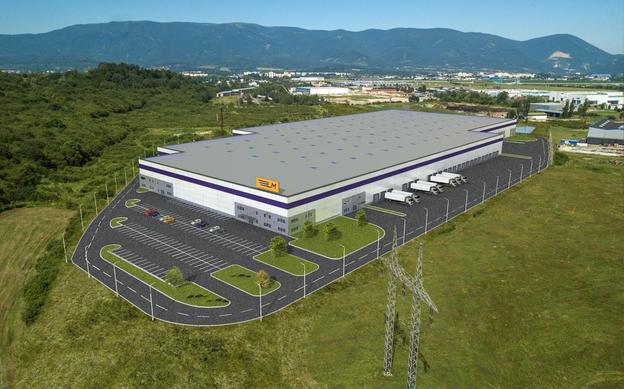For centuries, rivers were the main transport arteries between towns and cities. Today, highways fill that role. But zoning plans – known locally as master plans – for towns in Slovakia often do not recognise this, pushing new industrial and logistics zones to the outskirts of towns, to locations that are still too close to residential zones and too far from highways. Putting them beside highways would be a win-win situation for both affected residents and developers, says Tomáš Ostatník, Real Estate Executive at Holland and Company, a real estate investment and consulting company. But for that to happen, there would need to be a shift in the mindset when designing master plans, he explains.
The Slovak Spectator spoke with Ostatník about the challenges faced by industrial and logistics site developers in Slovakia, the impact of rising inflation and the Covid-19 pandemic on the sector, and whether companies want greener, but more expensive, premises.
What kind of reputation does Slovakia have as an investment location in the industrial and logistics real estate sector?
The reputation of Slovakia for the location of logistics and industrial warehouses is good. A particular benefit is our location in the heart of Europe. The labour advantage we once had has now passed – Slovaks no longer want to work in warehouses and manufacturing. There is a labour shortage in Slovakia and companies are forced to use foreign workers to fill vacancies. As a consequence, when signing contracts with clients for the lease of large industrial or logistics premises, i.e. 20,000 square metres or more, contracts to build dormitories are included. Slovakia’s competitive advantage over, let’s say Poland, Hungary or the Czech Republic, is that we also have speculative construction here, i.e. construction of premises without any rental contracts signed in advance. A healthy share of free premises is about 10 percent. In Slovakia the figure is around 6 percent. Another advantage of Slovakia is our euro currency, which makes the calculations for investors a lot easier and also enables them to avoid currency risk.
Tomáš Ostatník
Tomáš Ostatník graduated in International Financial Management from the Martin Luther University in Halle-Wittenberg. He spent also a significant amount of time working on the island of Nantucket in Massachusetts, USA, where he worked at several positions at the Sankaty Head Golf Club where he got inspired by the club members such as Bob Kuratek (former general manager of SHGC), Bob Right (former NBC executive) and Jack Welch (former GE chief executive), to come up with the idea of founding a real estate company now known as Holland and Company. During a 12-year career with real estate firm CBRE, he worked for multiple departments. In 2012 he was appointed Head of CBRE Industrial in Slovakia, where he managed a large number of industrial leasing and sales transactions that attracted tenants from city logistics schemes to international automotive suppliers to PSA Peugeot, Kia Slovakia, Volkswagen and Jaguar Land Rover. In September 2019 he joined the Austrian industrial real estate developer Go Asset, where he was responsible for the business development of large industrial parks under the brand name LOG Center R7 in Dunajská Streda in Slovakia as well as partially in Maribor and Koper in Slovenia. As of January 2022, he is a Real Estate Executive at the Holland and Company real estate consulting firm, focusing on logistics, manufacturing and e-commerce real estate. The company focuses on foreign firms, in particular from German- and English-speaking countries.
Who develops industrial and logistics real estate in Slovakia?
Most developers active in the industrial and logistics real estate sector are foreign companies with American capital behind them. These include, for example, Prologis, GLP, Mountpark, Panattoni, and Exeter. There are also some developers originating from the Netherlands acting from the Czech Republic, for example CTP, and other European countries. The American development companies active in this industrial and logistics real estate segment amount to over 50 percent of the warehousing/production space in Slovakia.
What are the most common problems encountered by investors in the industrial and logistics real estate sector in Slovakia?
One of the biggest problems they come up against is the permitting process – it lasts too long. Another challenge is with plots of land, with one main problem being that sometimes a single piece of land may be owned by several people. This problem dates back to the time of Maria Theresa, when the practice of inherited land being divided between heirs was introduced here. Often, when a developer finds land suitable for construction, it may be made up of several smaller plots, each of which is owned by 10 or possibly more people. They then need to contact each owner and persuade him or her to sell their share. Moreover, it is often the case that landowners have a very different view of the value of the land compared to the developer. The former will ask for around €100 per square metre, i.e. the price for land used for construction of family homes or blocks of flats, but the economy in the logistics and industrial sector – the cost of building an industrial hall or a warehouse and then the rental – puts the price at around €30 per square metre. So it may take as much as two to three years before land can be secured. This is why we focus on permitted land for industrial use, such as our project in Martin-Sučany, www.ILM.sk.
What about master plans?
This is another problem. In the past, cities were built along rivers, which served as the transport arteries between them. Today, those arteries are highways. But master plans are obsolete and do not recognise this. They often put future industrial parks close to the centres of towns and villages and next to residential areas. This suits neither residents nor park tenants. Their ideal location would be along highways, as this would solve the problem of the use of arable land flanking the highways, which today still suffers from transport pollution, although less so than in the past. The tenants would be satisfied too, as they would not need to lose time driving trucks either with raw materials or products through towns and villages. A change in the mindset of what master plans should look like would avoid situations like the one that recently developed in Dunajská Streda where a developer, in good faith, bought land on which to build a logistics park. But even though the master plan identifies the area as an industrial zone, local residents are now protesting against the development, claiming that they do not want logistics halls at the bottom of their gardens.
What are the main differences between the Slovak industrial and logistics real estate market and markets abroad?
Slovakia, historically, has a poor network of highways, as it used to be an agrarian country. Also, it has 5.4 million citizens and only three cities with a population exceeding 100,000 – Bratislava, Košice and Prešov. This determines the dynamics of the whole economy and the building of industrial and logistics facilities along the D1 highway which runs from Bratislava to Košice and around these cities. They are not evenly distributed across the country in the same way they are, for example, in the Czech Republic, where each big city has its own industrial and logistics hub. This is the biggest difference.
Has rising inflation affected the industrial and logistics real estate market in Slovakia?
It is similar to what has happened abroad. In the last six months we have seen an increase in industrial property rentals in basically every location and that is due to [rising] inflation and an increase in the prices of building materials. But this is happening in the Czech Republic, Austria, Hungary and Poland, too.
How has the Covid-19 pandemic and the growth of e-commerce affected demand for storage space in Slovakia?
The pandemic re-ignited the industrial and logistics real estate market. There was an increased interest in online shopping and therefore also demand for warehouses. What we are seeing now is a kind of consolidation. People have partly returned to bricks-and-mortar shops. Also, because of inflation they are not shopping as much as before. Consequently, e-commerce tenants that have, for example, rented 15,000m2 of storage premises but are not using 5,000m2 of it are putting up that spare space for rent. We refer to this phenomenon as “hidden vacancy”.
How has the rise in energy prices affected the industrial and logistics real estate sector?
This would be a question for tenants, who pay for utilities themselves. But energy prices do affect the production costs of building materials which is why the prices of these materials, along with construction costs in general, have also gone up.
What we are seeing in the sector is the rise of a green trend. This can be seen in, among other things, the installation of solar panels on the roofs of logistics halls, the installation of heat pumps, building of green facades, putting up beehives next to warehouses and so on. Meanwhile, tenants themselves are demanding green electricity as well as a reduction in dependence on Russian gas. Nevertheless, return on investment is still what matters most. Another thing we are seeing is that banks are indicating they will take into account whether developers’ projects are green when assessing their financing in the future.
Are developers getting BREEAM, LEED or WELL certificates for their industrial and logistics facilities?
At the moment, they’re more of a marketing tool. But with banks indicating terms of financing will be worse for old industrial and logistics halls compared to new, greener ones, the trend is obvious. With regard to this, we are seeing a shift in the mindset of tenants – while older managers have a preference for the economics [of a facility], younger ones who care about the Earth are pushing for greener facilities, even [if this means] higher costs.
Is the current cooling of the real estate market similar to the cooling which occurred in 2008?
The current cooling is not down to the collapse of a bank or a reversal of the economic situation, as was the case in 2008. This time there are several factors – inflation, high energy prices, increasing interest rates and the fact that many people spent their savings during the pandemic and are not shopping as much as before – at the same time. Having said that, I wouldn’t say there was a crisis at the moment. There has been some slowdown in the economy, but it depends on the sector. For example, tourism is thriving as people are eager to travel after Covid lockdowns.
Our experience in the industrial and logistics sector is similar. We keep receiving inquiries. It’s not like in 2008, when nobody wanted anything and everybody was struggling to survive. There may not be the double-digit growth that every company wants to see, but basically there is some growth. And a debate is beginning as to whether it is really necessary to have, especially in Europe, double-digit corporate growth and for the economy to be driven by increasing demand. Having one or two cars is fine, but do I really need to buy a third or a fourth? This brings us back to the size of the population – not only Slovakia’s but also Europe’s, as Slovakia produces to a large extent for the entire European market. If demographic trends do not change, there is no reason for consumption to grow.
What are your forecasts for the development of the industrial and logistics real estate market in Slovakia?
We expect demand for industrial and logistics real estate to increase. There are still companies operating in old premises and, as I mentioned, younger management does not want to operate in such premises anymore. Then there is the matter of so-called nearshoring. During the pandemic, companies found that having suppliers in China was not optimal. We feel there is now a push for firms to have their suppliers in Europe, with central Europe an attractive location for this. Then there is the war in Ukraine, which we see of course as a threat but more as an opportunity for Slovakia. We do not know when it will end, but we believe that when it eventually does the manufacturing and logistics sector can be expected to get a kick-start – logistics and production facilities will be established in Slovakia and only later will companies go further on into Ukraine.


 Tomáš Ostatník (source: Courtesy of Holland and Company)
Tomáš Ostatník (source: Courtesy of Holland and Company)
 Land for Industrial Park Martin Sučany (source: Courtesy of Holland and Company )
Land for Industrial Park Martin Sučany (source: Courtesy of Holland and Company )
 From left: Roman Lipták, Suzi Welch, Jack Welch, Tomáš Ostatník at Sankaty Head Golf Club, Nantucket Island, 2005. (source: Courtesy of Holland and Company )
From left: Roman Lipták, Suzi Welch, Jack Welch, Tomáš Ostatník at Sankaty Head Golf Club, Nantucket Island, 2005. (source: Courtesy of Holland and Company )